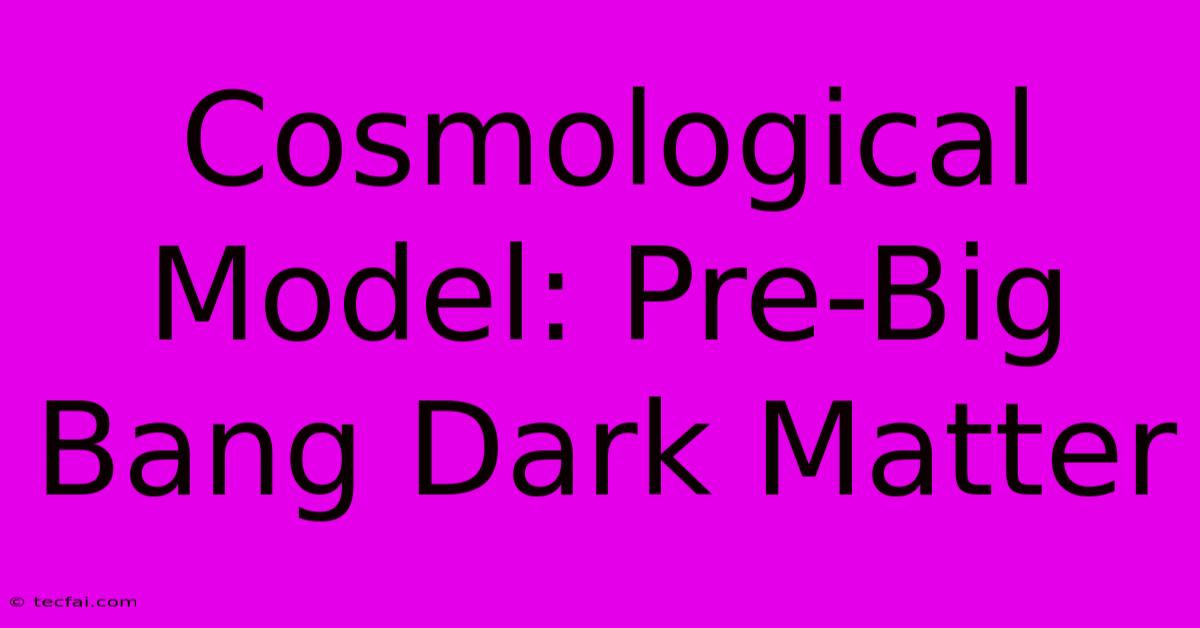Cosmological Model: Pre-Big Bang Dark Matter

Discover more detailed and exciting information on our website. Click the link below to start your adventure: Visit Best Website tecfai.com. Don't miss out!
Table of Contents
Cosmological Model: Pre-Big Bang Dark Matter
The Big Bang theory, while incredibly successful in explaining the universe's evolution from a hot, dense state, leaves some fundamental questions unanswered. One of the most persistent puzzles is the nature of dark matter, a mysterious substance accounting for roughly 85% of the universe's matter content. While its gravitational effects are observable, dark matter has yet to be directly detected, leading to numerous theoretical models attempting to explain its origin and properties. A particularly intriguing area of research explores the possibility of pre-Big Bang dark matter, suggesting its existence even before the inflationary epoch that initiated the Big Bang.
The Big Bang's Dark Matter Dilemma
The standard Big Bang model incorporates dark matter as a necessary component to explain galactic rotation curves, gravitational lensing, and the large-scale structure of the universe. However, the model doesn't explain where this dark matter came from. It's simply introduced as an initial condition. This lack of an explanatory mechanism for dark matter's origin motivates explorations beyond the standard model, including pre-Big Bang scenarios.
Pre-Big Bang Scenarios: A Glimpse Before the Bang
Pre-Big Bang models propose a universe existing before the Big Bang, potentially governed by different physical laws. These models often invoke concepts like string theory or loop quantum gravity to describe the universe's state prior to the inflationary epoch. Within these frameworks, several mechanisms could have generated dark matter:
-
String Theory and Dark Matter Production: String theory postulates the existence of extra spatial dimensions beyond the three we experience. These extra dimensions could have played a crucial role in the production of dark matter particles during a pre-Big Bang phase. The compactification of these extra dimensions during the transition to our current universe could have released dark matter particles, contributing to its abundance.
-
Loop Quantum Gravity and Pre-Big Bang Dark Matter: Loop quantum gravity offers an alternative approach to quantizing gravity, potentially avoiding the singularities predicted by general relativity. Within this framework, the universe could have existed in a pre-Big Bang state characterized by different topological structures. Transitions between these structures could have generated dark matter particles.
-
Symmetry Breaking and Dark Matter: In some pre-Big Bang scenarios, a phase transition involving spontaneous symmetry breaking could have generated dark matter particles. This is similar to how particle physics models explain the generation of other particles in the early universe, but occurring in a pre-Big Bang epoch.
Challenges and Future Directions
Investigating pre-Big Bang dark matter presents significant challenges. Testing these models requires detecting signatures that survived the Big Bang, which is inherently difficult. Furthermore, many pre-Big Bang models are still highly speculative, lacking the robust experimental or observational support found in the standard Big Bang model.
However, several promising avenues of research exist:
-
Gravitational Waves: Detecting gravitational waves from the pre-Big Bang era could provide crucial insights into the universe's primordial conditions, potentially shedding light on the origin of dark matter.
-
Cosmic Microwave Background Anomalies: Subtle anomalies in the cosmic microwave background radiation (CMB) could potentially reveal fingerprints of pre-Big Bang physics, offering clues to the existence and properties of pre-Big Bang dark matter.
-
Improved Dark Matter Detection Experiments: More sensitive dark matter detectors might reveal the nature of dark matter particles, potentially providing information consistent with pre-Big Bang production mechanisms.
Conclusion: An Open Frontier in Cosmology
The question of pre-Big Bang dark matter represents a fascinating and largely unexplored frontier in cosmology. While significant challenges remain, the potential rewards – a deeper understanding of the universe's origins and the nature of dark matter – make this area of research incredibly compelling. Continued theoretical development, coupled with increasingly sensitive observational techniques, will be crucial in unlocking the secrets of this mysterious substance and potentially revolutionizing our understanding of the cosmos. The exploration of pre-Big Bang dark matter pushes the boundaries of our knowledge, reminding us how much there is still to discover about the universe's vast and enigmatic history.

Thank you for visiting our website wich cover about Cosmological Model: Pre-Big Bang Dark Matter. We hope the information provided has been useful to you. Feel free to contact us if you have any questions or need further assistance. See you next time and dont miss to bookmark.
Featured Posts
-
Inverness Elf On The Shelf
Dec 01, 2024
-
Landon Jackson Injury Arkansas Update
Dec 01, 2024
-
Striking Workers Empty Woolworths Shelves
Dec 01, 2024
-
Stock Split Watch Growth Stock Up 510
Dec 01, 2024
-
Greer Lundell Lead Panthers Past Hurricanes
Dec 01, 2024
